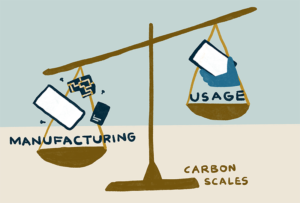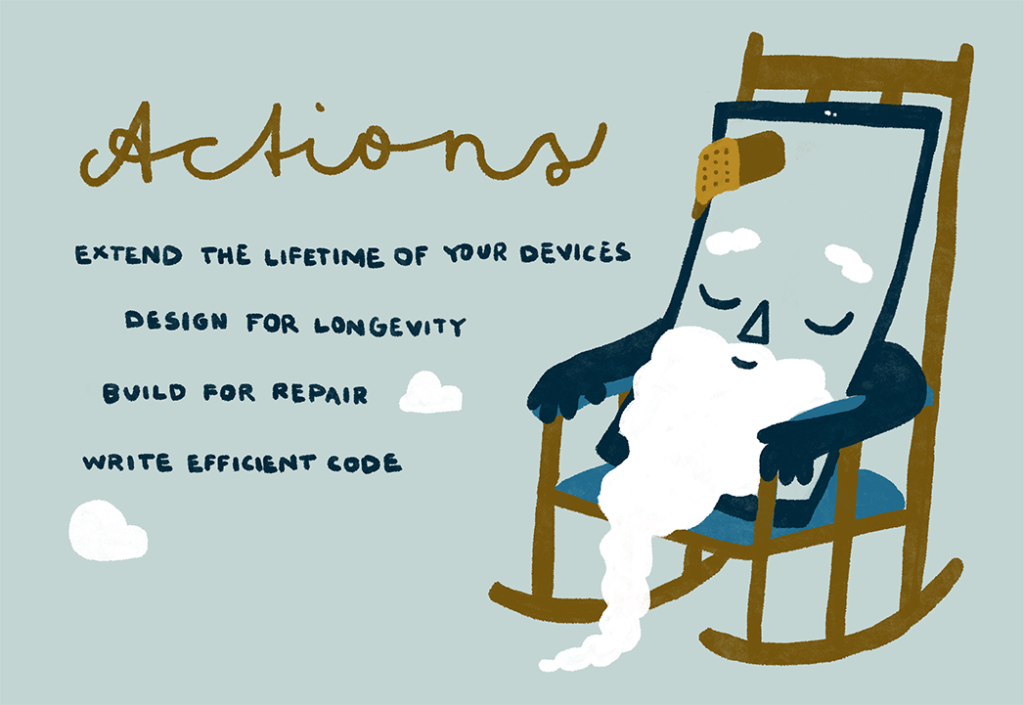When we talk about reducing our lifestyle carbon footprint, most of us think about turning down the heat in winter or driving or flying less. When the subject becomes electronic devices, similar tactics are often put in place: dim the display or put the laptop to sleep at night. These are all valid solutions and play an important part in reducing the carbon output of the system. However, what most of us may not realize is that the majority of the carbon footprint associated with your electronic device occurred before you ever purchased it.

The average US household has 11 connected devices ranging from tablets, computers, and cell phones to smart speakers and watches. Each of these devices generates a significant carbon footprint during the manufacturing phase. This is referred to as embodied carbon. Manufacturing a smartphone accounts for 85%-95% of the annual carbon footprint of the phone, and the average smartphone requires 55 Kg of CO2e to manufacture. Similarly, aSurface laptop has a carbon footprint of 152 Kg CO2e and 78% or 119 Kg is from manufacturing and 20% or 30 Kg is from use over a three-year lifetime. You would have to use a smartphone and Surface laptop for 10 years (assuming use is 10% of the overall carbon cost) and 11.7 years, respectively, to match the carbon emissions associated with manufacturing the devices.
It’s The Little Things That Matter
A phone or laptop are complex devices, with many parts and materials that make up the product from batteries and displays to the electronics that control the device. However, the biggest contributor to embodied carbon comes from the integrated circuits within the system especially as our devices get smaller and more powerful. These include components such as CPUs, graphics processing units or GPUs, solid-state drives or SSDs, memory, network processors, wireless processors, voltage regulators, and many more. Although integrated circuits are by nature quite small, they result in a disproportional environmental impact. Quite literally, it is the little things that matter the most when it comes to carbon emissions in electronic devices.
The silicon chips that go into the latest high-tech gadgets are the product of an extremely complex manufacturing process that requires significant energy and uses materials with high global warming potential (GWP). The chips are built layer by layer onto large wafers that can produce anywhere from 10s to 100s of chips depending on the size of the integrated circuit. Semiconductor manufacturing facilities require massive amounts of electricity annually, in the range of what it takes to power entire cities for the largest manufacturers. To address this issue, companies such as Taiwan Semiconductor Manufacturing Co (TSMC) are expanding their renewable energy purchases and are committing to 100% renewable energy by 2050. Given the push to renewable energy, the carbon footprint of devices should improve but it will take a few years.
Aging Gracefully
So where does this leave us now? How many of us keep our phones, tablets or laptops anywhere close to the 10 or 12 years to match the carbon associated with using the device? Will the hardware even work for that long? The devices will likely break down before reaching the decade-plus lifetime, but we can still do much better. The average replacement cycle in the US is about 2.5 years for cell phones and three to five years for tablets and laptops. With nearly 300M smartphones, 237M laptops, and countless other devices in US households in 2020, these devices account for a significant embodied carbon tax in addition to the electronic waste that is generated every replacement cycle.
We replace these devices for many reasons, but in most cases, it is not because the hardware is broken. Instead, the problems lie not with the main hardware, but in the peripherals and the software. A battery replacement can easily extend the lifetime of a sluggish phone or laptop by years. The other issue forcing upgrades is new applications such as games that are increasing in complexity and size. Newer apps may not work well on old hardware because of memory, storage or processor performance, and perfectly good hardware must be replaced to meet user needs.
Take Action
We can all take action to improve the carbon emissions resulting from electronic devices. If you use these devices, consider simple solutions to extend the lifetime of the device such as battery replacement or screen replacement on phones. If you absolutely must have the latest device, consider trade-in programs that many vendors offer. When the device is no longer usable, recycle the item with the manufacturer. Microsoft, for example, offers both trade-in and recycling programs.
If you are a builder of these devices, consider sizing the components to increase the usable lifetime. Upsizing the memory and storage on the device may increase its lifetime as the device becomes more crowded with use. This may sound contradictory since upsizing the hardware will also increase the carbon footprint of the device. There is a balancing act between designing for longevity and reducing manufacturing costs. Upsizing the storage from 64 GB to 128GB on a cell phone might increase the carbon footprint by a few kilograms, but it also might mean extending its usability for another year or two.
In addition to building right-sized products, build the device in a modular fashion so that it can be repaired rather than replaced. For example, laptops are great as portable devices, but one keyboard spill can destroy the entire system because the primary electronics reside under the keyboard. Using a remote keyboard or a replaceable keyboard as in the Surface Pro 7 means that a keyboard spill will not endanger the entire system. Similarly, having easily replaceable batteries and screens on cell phones increase their usable lifetime.
Finally, if you are a software developer, consider the efficiency of the code (both in size and performance), and features being utilized so that the software can run on as many existing devices as possible and not require additional hardware. Upsizing devices, as noted earlier, may lead to increased lifetimes but only if software developers continue to be efficient in their coding practices. Nature abhors a vacuum, but that premise should not apply to how you write code.
To conclude, cell phones, laptops, smart speakers, and a myriad of other devices have become an essential part of our daily life, but they come with a significant cost in terms of carbon and e-waste. However, with a little forethought and understanding of the carbon footprint of these devices, there are tangible and effective ways to reduce emissions with minimal adverse impact.



Indeed embodied carbon and electronic waste should be considered to reduce our carbon footprint. Somehow, the hardware industry has been going in the opposite direction: batteries and screens are not easily replaceable, upgrades are barely possible, and software updates are no longer supported/optimised after 2–3 years. The same happens in our social circle: the latest model has always more status than a long-lasting phone.
Great article! Thanks for spreading the green word. 🌱